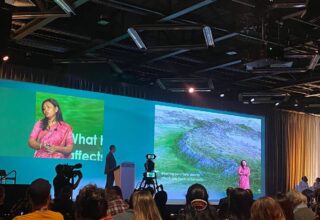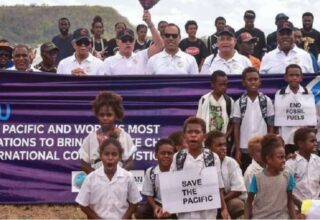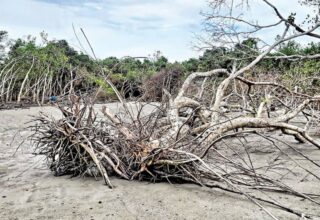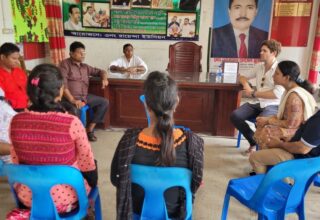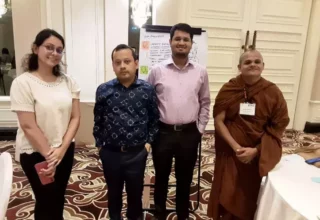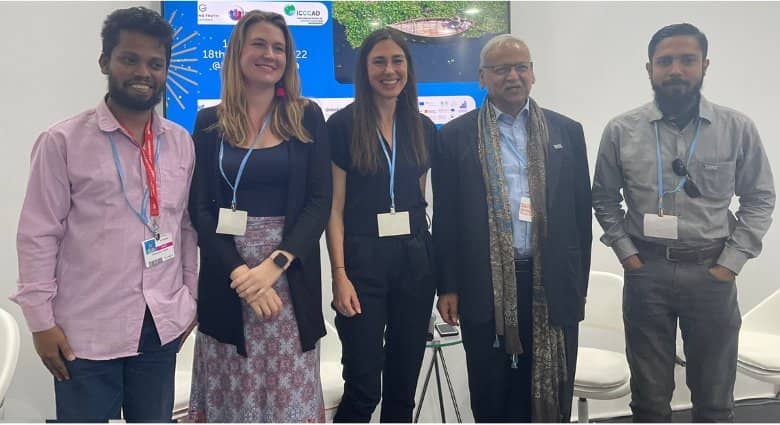
A conversation from COP27 on inclusive locally led adaptation.
When it comes to climate change adaptation in affected communities, top-down approaches where international- and national-level decision-makers drive interventions do not work. In recognition of this, efforts to promote locally led adaptation (LLA) have been growing steadily and in August 2022, over 100 organisations endorsed eight core principles to strengthen the movement. Local actors and communities must have a say in how, when, and where to adapt to ensure relevant, fair, and sustainable solutions. But communities are not monocultures, and not everyone is treated equally. Even the most well-meaning attempts at locally led programming can exclude the needs and demands of marginalised communities, especially women, girls, and sexual and gender minorities. Last month, we sat down in the LLA Pavilion at COP27 with theInternational Centre for Climate Change and Development (ICCCAD), the MenEngage Alliance and YouthNet for Climate Justice to discuss ways to turn the theory of local leadership into practice.
This is what the panellists had to say:
Meg Sattler: There is clearly a lot of will to make LLA work. What is the state of play, and why do you think it’s important?
Prof. Saleemul Huq: One of the positive outcomes of the Glasgow summit was a pledge from developed countries to double adaptation funding to 40% and most of them are reaching their targets. But it is not just about the quantity of money, it is also about the quality of the use of that money. The 6th Assessment Report of the IPCC found that many adaptation projects did not result in benefits for the intended beneficiaries and sometimes, even made things worse. One of the reasons for this was that projects were designed and delivered in a top-down manner with global funders and experts flying in and telling people what to do. Local people could’ve told them that the projects weren’t going to work but they weren’t consulted. This led to a collaborative movement within the adaptation arena to work on LLA that champions the need to consult local people and bring them into the design, implementation, monitoring, and evaluation of the projects that impact them.
Meg Sattler: Some of the LLA principles are difficult. Making sure to address structural inequalities and getting down to the lowest level of decision-making is probably easier in some communities than others. From the youth and gender perspective, how is this going and what still needs to be done?
Sohanur Rahman: Our solution to the climate crisis is localisation and decolonisation. The climate crisis is rooted in colonialism and destructive masculinity so we should focus on transforming masculinity and promoting allyship. We cannot achieve climate justice without gender justice, and we cannot achieve either without the allyship of men and boys. We have some demands at COP to ensure LLA. We need intersectional approaches and accountability. Day by day, COP is becoming more corporate, and people are losing their access to this process. Women and girls need to be included, not as tokens, but as active partners.
Meg Sattler: Given the shortfalls with COP, do you think that some of the change will come from the community level – and then there won’t be as much pressure on events like this to make the big decisions?
Prof. Saleemul Huq: We need to be deploying our efforts at all levels. The UNFCCC and COP process have evolved significantly. The negotiators that are sitting behind closed doors going over unintelligible text- I call that the talking COP. But then we also have the action COP, in places like the LLA pavilion where the people who are doing things are. Those who can come here have a responsibility to network and build alliances with like-minded constituencies. That is the real COP and the reason we are here: to galvanize action and combine forces with other people. We are not winning- we are still losing. But we must not give up.
Meg Sattler: One thing we’ve learned in the humanitarian space, is that most reporting is incorrect. A year ago, we had a conversation with Prof. Saleem to conduct a reality check on LLA and community engagement in adaptation programs. We’ve now finished that work. What were some of the findings and what were your reflections?
Elisa Schmidt: We spoke to over 2,000 people in 3 districts in Bangladesh and the sentiment was quite similar across the board. More than half of the people we spoke to do not feel sufficiently involved, do not feel like the process is very fair and there is a lack of clarity about who can access support and participate in adaptation programs. People don’t feel like they can provide feedback and even if they can, they don’t feel like their opinion matters. We did this exercise to collect evidence to bring to sessions like these and say to organizations that we need to do better because this is what communities are thinking. We are talking a lot about accountability to the communities we work with and understanding the relationship between communities and project implementers is critical for this.
Fahad Hossain: In Satkhira, there are people who feel included and people who don’t. The Munda community mentioned that many of the interventions in their area were not what they wanted. For instance, the cash they received to build stronger houses was not enough, so the houses keep getting damaged. There is also an idea that people next to the river or the sea are the most vulnerable but the Munda community, even though they are a bit inland, are vulnerable too because of structural issues. They don’t have their own land and the area they live in is so congested that they cannot plant trees to protect their homes from cyclones.
In another area, we heard that one organization engaged with the community from the beginning, asked them what they needed and provided support in a way that was useful to them. They ensured that the capacity of the community was built so they could run interventions themselves. When we asked what this organization could’ve done better, they said ‘nothing’. This project was successful because they involved the community from the beginning and their opinions were considered.
Meg Sattler: So our work pointed to things that clearly weren’t working and things that were. What other things seem to have been working from the local perspective?
Elisa Schmidt: Something that people mentioned a lot was the Cyclone Preparedness Program in Bangladesh, which saved many lives. We asked people whether the organizations working in their communities helped, and most people said yes. But they want to be more involved so they can do the work themselves. They don’t want to rely on external actors. Through our qualitative interviews, we learned how involved people want to be and how important it is to ensure that organizations promoting LLA are held accountable for their actions. Are they practicing what they preach? Are they doing what they write and present at sessions like these? We should be able to admit when approaches didn’t work, when we thought we were being participatory or inclusive, but people didn’t agree.
Meg Sattler: I think this sense of wanting to participate is something that we really see coming from young people here at COP27. Is that reflected in your work in Bangladesh and what do you think can be done to help facilitate this movement?
Sohanur Rahman: Sometimes, we might feel like young people are just saying they want climate justice, they want their future, but they are also really supporting vulnerable communities. They are in this crisis, and they are involved, they volunteer. For instance, in Bangladesh they work with the parliamentarians’ group to ensure climate finance governance and fundraise to help communities get clean water and embankments. We must shift power from the powerholders to the powerless. Youth and women are powerless, but they are not voiceless- they are just missing from the decision-making table. Youth participation in the COP process is growing but we must ensure to break down systematic barriers to ensure that youth-led, women-led, and community-based organizations can participate.
Elisa Schmidt: The second principle of addressing structural barriers is so important. Something that people said a lot to us in our project was that they didn’t feel free to talk about the actual power structures in place that were preventing them from increasing their resilience. There needs to be more thought into how people can be provided with a safe space to be honest about the problems they are facing without a fear of reprisal or concern that they will no longer receive the support that they need. We need to be comfortable having difficult conversations and call out people and institutions in a meaningful way.
Meg Sattler: If you think about the way that a single person in a community experiences and understands climate change and adaptation, it’s not the same way as it’s being discussed here. We don’t ask people for definitions of adaptation, humanitarian aid, anticipatory action but everything here is siloed, so removed from people’s lives. There are so many conflicting interests and where all the money comes from is so confusing. Uneven power dynamics are on full display. What are a couple of things that could shift some of that dynamic back to the local level so that these siloes can break down? What is looking promising?
Prof. Saleemul Huq: It is not easy, but one cannot give up. When we started the UNFCCC 30 years ago, the Least Developed Countries (LDCs) were identified as the most vulnerable, but they were not a formal group until COP6. Ever since then, I’ve been helping them become more effective in the negotiations, which are very complex. The agenda item that we got on Loss and Damage is not new, we have been fighting for this for 30 years. We got it because we successfully advocated for it, we brought allies together and we persuaded the blockers not to block it. To get the agenda item, we had to agree on a footnote that said that it could not be used for liability and compensation. We accepted it because that is not what we were invoking. Now, we are hoping to get a financing facility. There is a lot of pushback on setting it up here- there are a lot of questions about who will pay, who will get and who will manage the money. All those questions don’t need to be resolved here- we will set it up and come to COP28 to work out the details. Progress is incremental. These are very powerful countries that we convinced to do something against their judgment and will. So sometimes, we get small wins.
Originally this article was published by the Ground Truth Solutions.
A big thank you to the United Nations Capital Development Fund LoCAL Facility and ICCCAD for hosting us at the LLA pavilion and all the panellists.

